-

人教版高中英语必修3Astronomy the science of the stars说课稿3篇
Step 2 Pre-listeningAfter students finish their discussion, I will show a picture of Newton and ask them: Who is him? What is he famous for? Could you find out some words to describe him? Maybe students will answer that he is genius for his finding of theGravitation, making a great contribution to the progress of human being. At that time I will show another two pictures of Einstein and Hawking, letting students guess who they are and write down their idea about the Gravitation. For I have arranged them to search more information about the gravity before this class, Students have beenfamiliar with the topic and will not be afraid about this abstract conception, which is helpful for their listening.Step 3 While-listeningIn this step, students will be required to listen the material for three times. The first and listening is extensive listening and the second and third listening is intensive listening. In the first time, They are required to listen a material including Part 1 and Part 2 and choose the best summary of the listening text. After they choose the right answer, They also need work in group to explain what is wrong with the others. Then I will make a conclusion that we should pay attention to the first paragraph and last paragraph and some keys to get the main idea. By doing this, their capacity of generalization will have a great improvement.Before the second listening, I will ask students to scan the blank on the power point quickly and ask them to note down some key words .Then ask them to listen to the Part 1again and fill the first column of the chart. Maybe some students just show the ideas of these three scientists an still can’t catch their development of gravity. Therefore, I will ask them to listen to Part 2 again and fill in the rest. After finish the listening, I will give them ten minutes to discuss with their partner. I will also guidethem to improve their answers when they discuss with others.

人教版高中英语必修4A taste of English Humor说课稿3篇
Then I would ask them to think of a funny English or Chinese and tell it to partners. While telling stories, they can use expressions and some acting to help make the story funny. 5 minutes would be given to do this.Those stories they told there will be the material for their writing. Soletting them tell it at first is helpful. And they can make a difference between telling a funny story and writing it down. Generally speaking, it is difficult forstudents to write well because they don’t know what to write and how to write. Asking them to tell their own stories at first can help them come up with what to write.After their telling, I would invite someone to share his/her story with all of us and I would write it down on the blackboard.This example story would be used as a sample to illustrate the format of funny story. Different from a story from teacher or textbook, a story from students can obviously become a interesting material to draw students’ attention.Then I would ask the whole class to put this story into several parts. It might be a little bit difficult for them. So I would ask them to find out whether all the sentences are necessary. After delete some sentences, there are 6 sentences left behind. Then they can easily put them into three parts. After interaction with students, I would teach them the right terms for each part and conclude the format of funny story.This step is the key and difficult point in my lesson. So I mainly usetask-based teaching method in this part and the task for students was divided into several stages. With the separated difficult level, students can find there are usually three parts in writing. They can also learn to write without the unnecessary parts in the process of analyzing. And then I wouldn’t rush to tell them the right terms to them directly. Instead, I would ask them to name them by their own. A confused mind is better for acquiring knowledge.While-writing:Then I would give students 7 minutes to write down this story, without other requirements.With all the preparations in pre-writing, students’ difficulties were cleared. So it would be much easier for them to write down the story within 7 minutes. There are no other requirements because students’ first writing is actually a drafting. It would be revise and edit several times later. Writing, as a skill

人教版高中英语必修4Women of achievement说课稿4篇
Good morning, distinguished judges:It’s my honor to talk about my teaching ideas with you. Today my topic is Women of Achievement. My presentation consists of six parts: the analysis of teaching material and student, teaching aims, key and difficult points, teaching and studying method, teaching procedures and blackboard design.First, let’s focus on the analysis of teaching material. This lesson is from New Senior English for China Student’s Book 4 Unit 1, the reading part. The main topic of the passage is the introduction of a student of Africanwildlife. After this lesson, the students will learn more information about her studying chimps in Africa, and their reading and speaking abilities can be developed as well.The next part is the analysis of students. My students are in senior high students. They have learnt English for many years, they’ve known many words and sentences, but their speaking and reading abilities are still not very good. So I will practice their speaking and reading abilities through different exercises.According to the New Standard Curriculum and the present situation, I set the teaching aims as follows: firstly, knowledge aims. Students can grasp some new words, such as worthwhile, move off. Moreover, students can understand the content of the passage and get familiar with the topic of studying chimps in wildlife. Secondly, ability aims. Students can use reading strategies such as skimming and scanning in reading process. Thirdly, emotional aims. Students can have the awareness of protecting animals and care about animals.Based on the above analysis, the key point of this lesson is to get the main idea and the detailed information from the passage; the difficult point is to talk about the wildlife protection and use reading strategies.

人教版高中英语必修3Festivals around the World说课稿3篇
Teaching plan for Unit 1 book3Good morning, teachers. It’s my great pleasure to be here because I can share my lesson with you and I can learn a lot from it. I’ll begin my lesson from the following four parts, the teaching material, the teaching methods, the studying methods and the teaching procedure.Firstly, let me talk about the teaching material. The content of my lesson is the reading passage festivals and celebrations of Unit 1 Festivals around the world. This passage is about festivals and celebrations. By studying this passage, we’ll enable the students to know that festivals exit everywhere, and many of festivals in different countries celebrate similar ideas. As we all know, the reading passage is the center of each unit. If the Ss can learn it well, it will be helpful to make the Ss learn the rest of this unit.After studying the teaching material, I think the teaching aims are as the followings:1. Knowledge aims:(1) The Ss can master the usage of the important words andexpressions.(2)The Ss can use the __________________ (grammar) in the proper situation.Make students know about the festivals all over the world and the detail of the festivals, such as origin, content, and the date of the holiday festivals.2. Ability aims:(1) Students can talk about festivals and celebrations in English(2) To improve the student’s reading ability, especially their skimming and scanning ability.3. Emotion aims:Make the Ss know about the foreign festivals, and respect other countries’ custom.Next, let’s come to the important points and the difficult points.The important point is how to make the Ss understand the text better and the difficult point is how can they talk about it. secondly, Teaching Methods:1. task-based Language Teaching2. Computer assisted language teaching.3. question-and–answer methodThirdly, Studying Methods:

人教版高中英语必修3Healthy Eating说课稿4篇
Language learning needs a context, which can help the learners to understand the language and then can product comprehensible output, so computer has the advantages to make the materials attractive.Part 3 Learning MethodsTask-based, self-dependent and cooperative learningPart 4 Teaching ProcedureStep One Lead-in“Interest is the best teacher.” Therefore, at the very beginning of the class, I should spark the students’ mind to focus on the centre topic “the band”. I’ll show some pictures of food to attract their attention and then bring some questions.Question:What kind of food they like?What should go into a good meal?The answers must relate to the diet. After this, the students will be eager to know something about a balance diet and this is the very time to naturally lead the class into Step 2Step 2 Reading for information: skimming and scanning In this step, I use Task-based Language Teaching method, which can give students a clear and specific purpose while skimming and scanning the context.Task 1 General ideaThe students will be asked to just glance at the title and the pictures of the passage, and then guess what they will read in the text. And they’ll be divided into groups of four to have a discussion.The purpose is to inspire the students to read actively, not passively. In addition, the task is to develop the students’ reading skill by making prediction and to encourage the students to express their thoughts in English and cooperate with each other.Task 2 Main idea of each paragraphCooperative learning can raise the students’ interest and create an atmosphere of achievement. Based on this theory, I divide the whole class into 4 groups to skim the whole text and get the main idea of each paragraph.

人教版高中英语必修3The million pound bank note说课稿3篇
在接下来的细读环节,我套用了高考对阅读理解的考查方式设置了5个问题,分别为三个推理判断题,一个细节题和一个主旨大意题。学生需要对文章的内容进行分析、归纳、推理、猜测等高级思维活动才能做出正确的回答。【设计意图】这一过程是对学生进行细读的训练,培养学生获取特定信息和挖掘文章深层次信息的能力。第三环节:Intensive-reading (精读) 15′第三个环节精读,既是最重要的环节,也是突破本课重难点的关键。首先,让学生思考剧本中人物看到百万英镑前后的态度发生了怎样的变化。其次,让学生仔细阅读文章,找出可以表现人物态度变化的具体的语言和动作。最后,让学生总结人物的态度发生变化的根本原因是什么,从而引出Money Talks, 供学生思考。【设计意图】通过一系列的活动培养学生学习从人物的语言和动作探究人物的心理,使学生进一步体会戏剧语言的魅力,从而对文章背后所反映的社会问题进行思考,也为下一步的讨论环节做好铺垫。

人教版高中英语必修5First aid说课稿6篇
In this class, I have 3 teaching aims, that is, knowledge aims, ability aims and emotion aims.1) Knowledge-Teach students new words and expressions, such as temporary, bleed,sprain choke, first aid, fall ill and so on.-Enable students to have a better understanding for some basic knowledge of first aid.2) Ability-Train students’ speaking, reading and writing abilities by different teaching activities, such as skimming, comprehending, team work, role play, retelling and writing.-Develop students’ reading strategy on how to move general idea to specific information.3) Emotion-Promote students’ awareness of giving first aid.- Cultivate students’ creativities.Then let’s come to my teaching methods and activities.III. Teaching methods and activities:To achieve different teaching aims, various kinds of teaching methods and activities will be adopted throughout this period, such as TBL (task-based learning), skimming, team work, brainstorm and others, which can offer students opportunities to fulfill tasks in which they can use language to achieve a specific outcome.IV. Teaching aids:Computer and blackboardV. Teaching important points:1) Make students have a clear mind for the structure of the text.2) Help students understand the theme of the text.VI. Teaching difficulties:1) So many new words may affect students’ understanding.2) How to get students to know about the functions of the skin and thecauses, characteristics and treatments for different degree burns,and the knowledge about giving first aid. VII. Blackboard design:

人教版高中英语必修5Life in the Future说课稿5篇
Good afternoon, everyone. It’s my great pleasure to be here sharing my lesson with you. The content of my lesson is Senior English for China Book5 Unit 3 Life in the Future. I’ll be ready to begin this lesson from six parts: Analysis of the teaching material, Analysis of the students, Teaching aims and important and difficult points, Teaching methods and aids, Teaching procedures, and Blackboard design. First, let me talk about the teaching material.Part 1 Analysis of the Teaching Material:This unit is about what human beings’ life will be like in about one thousand years. By studying of this unit, we’ll Enable the students to know the changes in humans’ life and some new inventions bringing about the change and develop the interest in science. This lesson plays an important part in the English teaching in this unit. This is an important lesson in Book Five. From this lesson, it starts asking the Ss to grasp contents of each passage. Therefore, this lesson is in the important position of the teaching material. If the Ss can learn it well, it will be helpful to make the Ss learn the rest of this unit.Part 2 Analysis of the SsAs Senior2 Ss, they are at different levels of English fluency, some of them have lost interest in English. So during the lesson, I arrange a variety of activities to let all of them join in to attract their interest and let them be confident and taste the joy of success.

人教版高中英语必修5The United Kingdom说课稿4篇
Teaching Aims:Knowledge 1. Get the students to learn the useful new words and expressions in this section. Aims:2. Let the students learn about how the UK was formed and the four groups of invaders.1. Develop students’ reading ability and let them learn different Ability reading skills. Aims:2. Enable students to learn to talk about the United Kingdom and the Union Jack Emotional 1. Let students know more about the UK2. Develop students’ sense of cooperative learning Aims:Teaching Important Points:1. Let the students learn about the countries of the United Kingdom and the Union Jack2. Get the students to read the passage and know about how the UK was formed and the four groups of invaders.3. Have the students learn different reading skills.Teaching Difficult Ponts:1. Develop students’ reading ability.2. Enable students to talk about the United Kingdom and the Union Jack.3. Let students learn how the UK was formed geographically and historically.Teaching Methods:Showing pictures, asking, exercising, listening, reading etc.Teaching Aids:A computer,a projector and a blackboard.Teaching Procedures: 1) Show a map of the world, ask students the following questions:Where is the UK?What’s the full name of the UK?2) Ask the students work in pairs to do the quiz on Page 9.Do you want to test how many things you know about the United Kingdom? Let’s have a small test.Using the map on P9, students answer the following questions:?How many countries does the UK consist of? What are they??England is divided into three main areas. Do you know what they are? 1) Scanning (10Minutes )Let the students hold the questions asked in pre-reading and read the passagequickly and then let them do the following exercise.Join lines to the right answer.

小学美术冀美版一年级下册《19大树的故事》说课稿
(1) 美育目标:通过引导学生初步认识人与自然的关系,激发学生热爱自然,保护绿色生命的情感。(2) 知识目标:鼓励学生大胆地、有个性的用自编故事、绘画方式等去表达对大树的情感。(3) 能力目标:通过本课的学习,培养学生的想象能力、儿童画创作能力、语言表达能力等。
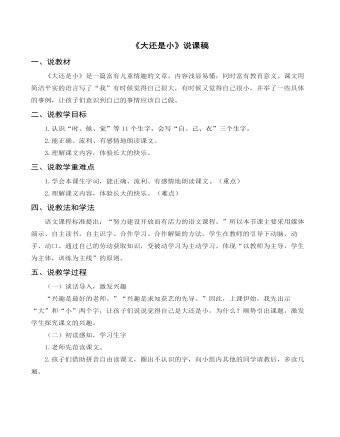
部编人教版一年级上册《大还是小》说课稿
二、说教学目标1.认识“时、候、觉”等11个生字,会写“自、己、衣”三个生字。2.能正确、流利、有感情地朗读课文。3.理解课文内容,体验长大的快乐。三、说教学重难点1.学会本课生字词,能正确、流利、有感情地朗读课文。(重点)?2.理解课文内容,体验长大的快乐。(难点)四、说教法和学法语文课程标准提出:“努力建设开放而有活力的语文课程。”所以本节课主要采用媒体演示、自主读书,自主识字、合作学习、合作解疑的方法。学生在教师的引导下动脑、动手、动口。通过自己的劳动获取知识,变被动学习为主动学习。体现“以教师为主导,学生为主体,训练为主线”的原则。

部编人教版三年级上册《大自然的声音》说课稿
四、说教法学法这篇课文浅显易懂、生动有趣,在教学中应以读为本,应让学生在主动积极的思维和情感活动中,加深理解和体验,有所感悟和思考,受到情感熏陶,获得思想启迪,享受审美乐趣。因此,在教学中,引导学生入境、想象、美读、感悟,引导学生在读中感悟,在读中激情,在读中体验、品味,让学生真正走进大自然,体验大自然,发现大自然,激发学生热爱大自然的感情。 1.创设情境,走进文本:在教学中,要让学生自己阅读、自己学会阅读。教学中我创设了情境,让大自然带领学生聆听了一场特殊的音乐会,缩短了学生与文本的空间距离,让学生置身于自然之中,俨然是大自然中的一员,在情境中感知,体会到大自然声音的美妙,与文本产生了共鸣,激发了学生的学习兴趣,让学生成为学习的主人。 2.美读感悟,放飞想象:在教学中始终以“大自然中这些声音真是太美妙了”贯串始终,重点指导学生美读课文,抓住描写声音的词,边读边思考,大胆的展开想象,有感情地读,配乐读,自由读,分组读,师生合读,全班齐读,在读中生成自己独特的感受、体验和理解,感受风声的美妙,水声的有趣,动物声的快乐,同时培养学生的语感。 3.拓展延伸,提高能力:布置学生课后在大自然找一些新发现,拓展学生的学习空间,扩大视野,增长知识。让学生在课内外的学习中提高语文素养。
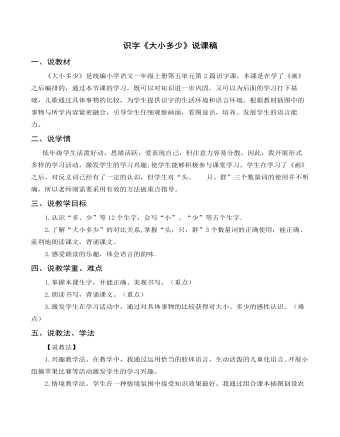
部编人教版一年级上册识字《大小多少》说课稿
五、说教法、学法【说教法】? ???1.兴趣教学法。在教学中,我通过运用恰当的肢体语言、生动活泼的儿童化语言,开展小组摘苹果比赛等活动激发学生的学习兴趣。? ???2.情境教学法。学生在一种情境氛围中接受知识效果最好。我通过组合课本插图创设农家小院情境,通过文本和课件互为直观感知,调动学生的多种感官直接参与学习.? ???3.赏识教学法。低年级的孩子喜欢被表扬。在学生练字,读词、展示学习成果等环节,我灵活运用针对性较强的赏识语言、友善的动作等方式对学生加以赏识。? 【说学法】?1.让学生在合作探究中学。合作探究学习关注的是学生的能力,我通过让学生互相探究记字方法,联系生活自编儿歌,让学生的思维力,想象力,创造力得到充分的展示。???2.让学生在读中学。朗读是学生获得情感体验的重要途径。本课教学以读为本,有目的组织形式多样的读词,读文活动,在反复的诵读中,体会韵文的语言美。???3.让学生在快乐中学。我们常说寓教于乐。本课教学我开展形式多样的教学活动,如开火车游戏,拍手读,小组比赛等,让学生在快乐中积累了语言文字。
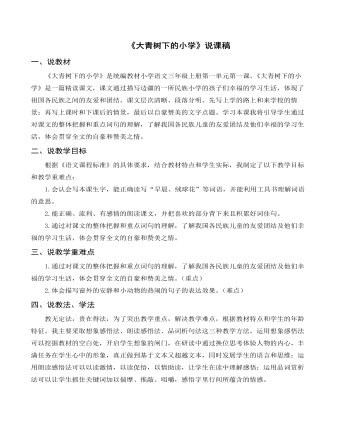
部编人教版三年级上册《大青树下的小学》说课稿
三、说教学重难点1.通过对课文的整体把握和重点词句的理解,了解我国各民族儿童的友爱团结及他们幸福的学习生活,体会贯穿全文的自豪和赞美之情。(重点)2.体会描写窗外的安静和小动物的热闹的句子的表达效果。(难点)四、说教法、学法教无定法,贵在得法,为了突出教学重点,解决教学难点,根据教材特点和学生的年龄特征。我主要采取想象感悟法、朗读感悟法、品词析句法这三种教学方法。运用想象感悟法可以挖掘教材的空白处,开启学生想象的闸门,在研读中通过换位思考体验人物的内心,丰满任务在学生心中的形象,真正做到基于文本又超越文本,同时发展学生的语言和思维;运用朗读感悟法可以以读激情,以读促悟,以情助读,让学生在读中理解感悟;运用品词赏析法可以让学生抓住关键词加以揣摩、推敲、咀嚼,感悟字里行间所蕴含的情感。
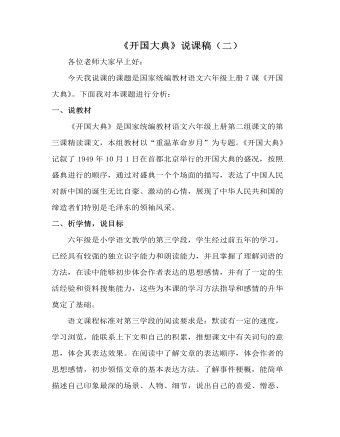
部编人教版六年级上册《开国大典》说课稿(二)
一、说教材《开国大典》是国家统编教材语文六年级上册第二组课文的第三课精读课文,本组教材以“重温革命岁月”为专题。《开国大典》记叙了1949年10月1日在首都北京举行的开国大典的盛况,按照盛典进行的顺序,通过对盛典一个个场面的描写,表达了中国人民对新中国的诞生无比自豪、激动的心情,展现了中华人民共和国的缔造者们特别是毛泽东的领袖风采。二、析学情,说目标六年级是小学语文教学的第三学段,学生经过前五年的学习,已经具有较强的独立识字能力和朗读能力,并且掌握了理解词语的方法,在读中能够初步体会作者表达的思想感情,并有了一定的生活经验和资料搜集能力,这些为本课的学习方法指导和感情的升华奠定了基础。
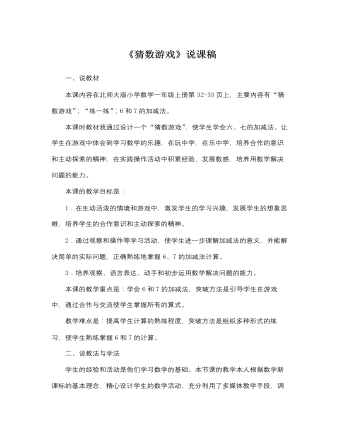
北师大版小学数学一年级上册《猜数游戏》说课稿
二、说教法与学法学生的经验和活动是他们学习数学的基础。本节课的教学本人根据数学新课标的基本理念,精心设计学生的数学活动,充分利用了多媒体教学手段,调动学生多种感官参与学习。让学生在实际中运用所学知识,体现了数学来源于生活,生活离不开数学。整节课以游戏、活动为主线,把教学内容清晰有趣地串了起来,设计了新颖的情景教学和动画故事,尽可能的激发学生的求知欲望。教学过程紧扣教材,层层递进,环环相扣,教师能根据学生的实际适时的引导,使整节课能顺利完成教学任务。有效的学习就是激励学生动手实践、自主探索与合作交流。本课教学中,本人就注意实践操作与游戏活动有机地结合,让学生在玩、交流中思考,在思考中探索,获取新知。三、说教学过程本节课的教学我主要设计了六个环节:提问导入、猜数游戏、实际应用、回顾总结、课堂作业。
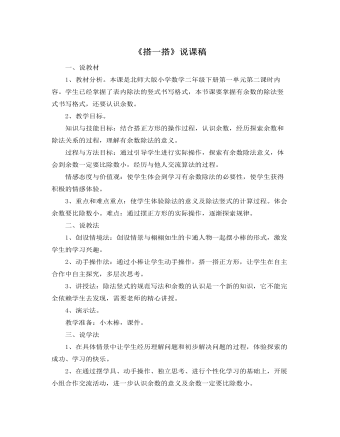
北师大版小学数学二年级下册《搭一搭》说课稿
(1)课件显示搭正方形的画面以及问题“4根小棒搭一个正方形,13根小棒可以搭多少个正方形,还剩几根?”。(2)组织小组讨论:有13根小棒,能搭几个正方形?请每个同学利用学具摆一摆,再依据上节课学习的除法算式,小组内讨论用竖式怎样表示。【设计意图:通过摆小棒搭正方形和自主探究等开发学生思维,促进学生多层次思考,培养孩子良好的思维方式,推动学生积极思考,逐步开阔学生解决问题的思路,培养学生横向思维能力。】(3)进行全班交流。指名回答;引导学生探究竖式各数表示的意思及单位名称的写法,并进一步认识余数。课件显示搭小棒的过程及横式和竖式:13÷4=3(个)……1(根)答:可以搭3个正方形,还剩1根。引导学生认识竖式中:“13”表示把13根小棒拿去分,“4”表示摆一个正方形需要4根小棒,“3”表示可以摆3个正方形(强调单位“个”),“12”表示3个正方形共12根(4×3=12)。“1”表示摆了3个后还剩下1根(强调单位:“根”),说明“1”是这个竖式的余数,这1根不能再继续往下分了。
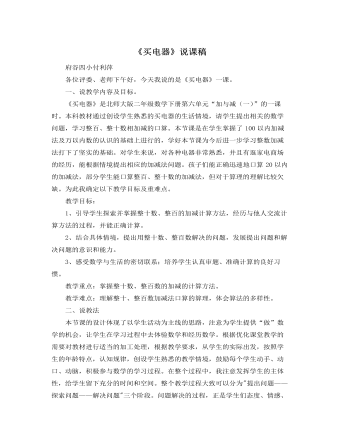
北师大版小学数学二年级下册《买电器》说课稿
一、说教学内容及目标。《买电器》是北师大版二年级数学下册第六单元“加与减(一)”的一课时。本科教材通过创设学生熟悉的买电器的生活情境,请学生提出相关的数学问题,学习整百、整十数相加减的口算。本节课是在学生掌握了100以内加减法及万以内数的认识的基础上进行的,学好本节课为今后进一步学习整数加减法打下了坚实的基础。对学生来说,对各种电器非常熟悉,并且有逛家电商场的经历,能根据情境提出相应的加减法问题。孩子们能正确迅速地口算20以内的加减法,部分学生能口算整百、整十数的加减法,但对于算理的理解比较欠缺。为此我确定以下教学目标及重难点。教学目标:1、引导学生探索并掌握整十数、整百的加减计算方法,经历与他人交流计算方法的过程,并能正确计算。2、结合具体情境,提出用整十数、整百数解决的问题,发展提出问题和解决问题的意识和能力。
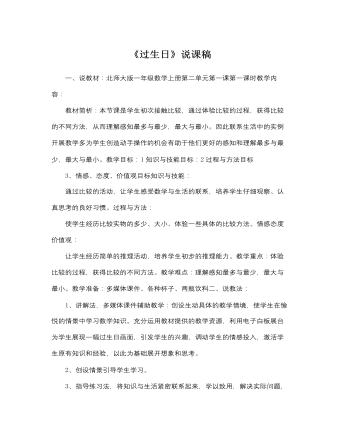
北师大版小学数学一年级上册《过生日》说课稿
3、情感、态度、价值观目标知识与技能:通过比较的活动,让学生感受数学与生活的联系,培养学生仔细观察、认真思考的良好习惯。过程与方法:使学生经历比较实物的多少、大小、体验一些具体的比较方法。情感态度价值观:让学生经历简单的推理活动,培养学生初步的推理能力。教学重点:体验比较的过程,获得比较的不同方法。教学难点:理解感知最多与最少,最大与最小。教学准备:多媒体课件、各种杯子、两瓶饮料二、说教法:1、讲解法,多媒体课件辅助教学:创设生动具体的教学情境,使学生在愉悦的情景中学习数学知识。充分运用教材提供的教学资源,利用电子白板展台为学生展现一幅过生日画面,引发学生的兴趣,调动学生的情感投入,激活学生原有知识和经验,以此为基础展开想象和思考。
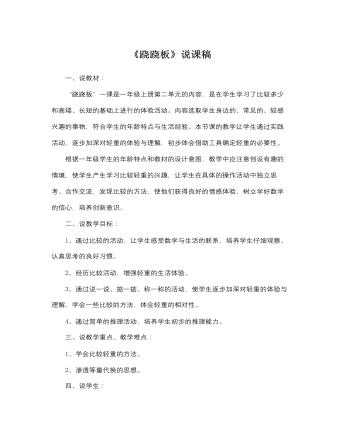
北师大版小学数学一年级上册《跷跷板》说课稿
一、说教材:“跷跷板”一课是一年级上册第二单元的内容,是在学生学习了比较多少和高矮、长短的基础上进行的体验活动。内容选取学生身边的、常见的、较感兴趣的事物,符合学生的年龄特点与生活经验。本节课的教学让学生通过实践活动,逐步加深对轻重的体验与理解,初步体会借助工具确定轻重的必要性。根据一年级学生的年龄特点和教材的设计意图,教学中应注意创设有趣的情境,使学生产生学习比较轻重的兴趣,让学生在具体的操作活动中独立思考、合作交流,发现比较的方法,使他们获得良好的情感体验,树立学好数学的信心,培养创新意识。二、说教学目标:1、通过比较的活动,让学生感受数学与生活的联系,培养学生仔细观察、认真思考的良好习惯。2、经历比较活动,增强轻重的生活体验。3、通过说一说、掂一掂、称一称的活动,使学生逐步加深对轻重的体验与理解,学会一些比较的方法,体会轻重的相对性。4、通过简单的推理活动,培养学生初步的推理能力。